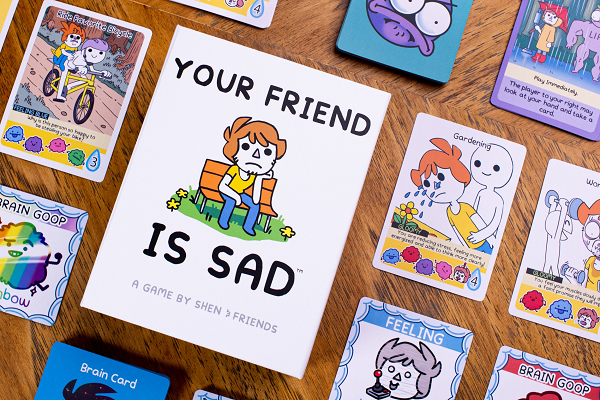Your Friend Is Sad: Let's Brighten Up Their Day!

Your friend is sad. How will you help cheer them up? Play a game, watch a movie, summon Cthulhu? Use emotions, brains, and life in this set collecting card game about being a good friend.
Published by Jason Anarchy Games, Your Friend Is Sad is designed for 1-4 players, with a playtime of 30 minutes.
Gameplay
Each player starts with a hand of five brain cards. Brain cards are a specific color of brain goop or a specific feeling. Four brain cards are then placed face-up in the center of the table to form the repressed memories display, and four cheer up cards are placed face-up on the table to form their own display. Each cheer up card belongs to one of four types of sadness groups, and lists how many points it is worth, and which feelings and brain goop colors it needs in order to be claimed.
On your turn you start by discarding one card from the repressed memories display and drawing a new card to replace it. You may then either draw two brain cards from the brain deck, or trade one brain card from your hand with one in the repressed memories display. If you do the latter, you also get to draw a life card. Life cards have effects that often help you, such as allowing you to steal specific color brain goop cards from all the other players, but sometimes will have effects that are detrimental to you. Sometimes you get to choose when to play a life card, sometimes it must be played immediately.
Next, you may choose to discard a feeling brain card or a vibe bot brain card (these are wild cards in the brain deck that can act as any feeling) to draw a life card. Finally, if you have the correct combination of brain cards, you can choose to discard them in order to claim a cheer up card from the display. A new cheer up card is immediately drawn to refill the display. If you have the necessary cards, you can claim multiple cheer up cards on your turn. Your turn now ends and it is the next player's turn.
If you ever exceed 10 brain cards in your hand, you must either discard all of them and draw a new hand of five cards, or you lay them all face-up on the table, and until you are back to 10 cards or less other players may choose on their turn to swap cards from their hand with cards in yours instead of the repressed memories display.
The first player who scores 13 or more points across their claimed cheer up cards, or completes three cheer up cards all belonging to the same time of sadness group, wins the game.

Photo provided by the publisher
Review
The star of Your Friend is Sad is definitely the artwork. It has so much character and is very unique, and is brought together quite nicely with flavor text. It carries a lot of weight for the game and carries it well. The theming is enjoyable too, and it’s fun to complete these different activities on the cheer up cards and build up a little story of how you’re setting out to cheer up your friend.
Gameplay is an easy-to-learn blend of set collection, take-that, and luck. Sometimes the cards you need just aren’t on the table, in which case going for life cards is often your only real shot. It’s fun that these are unpredictable and have a small chance of hurting you, but typically are quite take-that heavy.
The mechanism for exceeding your hand limit is clever, and a nice alternative to simply discarding down. This situation is more likely to happen in games with a higher player count, when you might accidentally steal a substantial number of cards with a life card, but it’s a clever twist on a rule that pops up a lot in such games.
Some life cards are more powerful than others depending on the number of players, but the dynamic in general changes for different sizes of groups. In a two-player game, the game is tight with lots of back and forth of playing life cards against each other, holding off to play specific cards when you think it will be most valuable. At higher player counts, you might be tracking less what cards each player has drawn, but you’re more likely to steal a larger number of cards with certain plays. We did find storing up life cards and playing multiple ones on a single turn could end up being quite a powerful move.
There were a couple of effects on the life card and how they played out that we found to have a little bit of gray area, but in general, the rules are easy to learn.
Your Friend is Sad is definitely quite a light game, with lots of luck and victories that can be stolen with a few take-that cards, so it won’t be for everyone, but it can be quite fun if not taken too seriously, and it’s a good representation of this type of fluffy card game.
Pros: Theme and artwork tie together really nicely and add a lot to the gameplay
Cons: Lots of luck, a good bit of take-that, some vagueness in the life card abilities
Disclosure: We received a complimentary review copy of this game.







